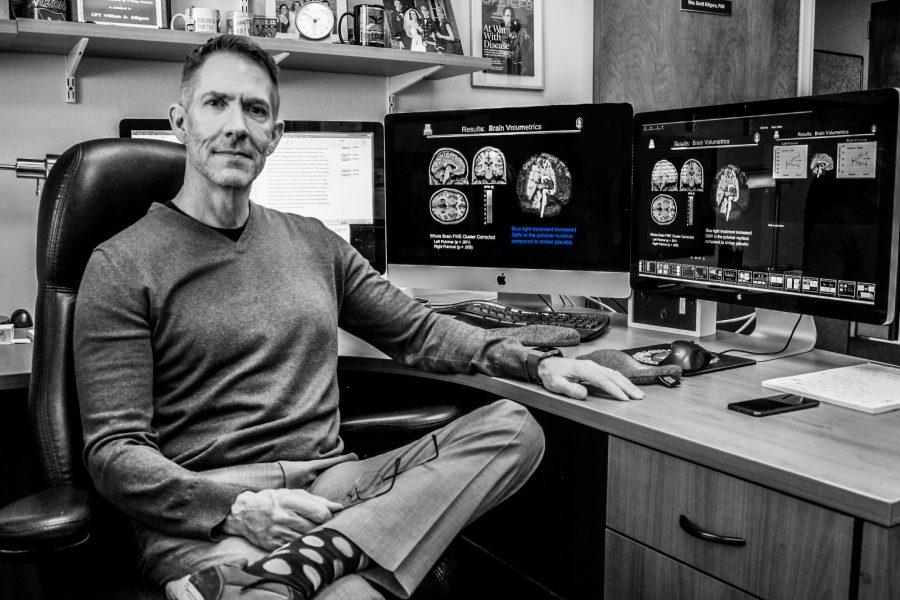In the age of technology, almost everybody is exposed to blue light on a daily basis. In fact, the phone, computer or tablet you may be reading this story on is emanating blue light without you even realizing it.
Often times blue light gets a bad reputation because of the way its wavelength affects human circadian rhythms. Blue light inhibits the release of melatonin, the primary hormone responsible for regulating the sleep/wake cycle in humans.
William D. “Scott” Killgore, Ph.D. a psychiatry professor at the University of Arizona’s College of Medicine — Tucson, is the lead author on a new study that indicates timely blue light exposure can help patients who have suffered minor traumatic brain injuries (mTBI).
An mTBI occurs when a person experiences a physical force that causes damage to the brain on a microscopic level, leading to a brief alternation of consciousness, according to Killgore.
“Typically this occurs through a physical impact to the head, a rapid rotation of the head or a shock wave to the soft tissue of the body that increases blood pressure to the brain, leading to microscopic bursting of blood vessels in the brain,” Killgore said.
After experiencing an mTBI, patients often struggle with maintaining a proper sleep schedule. However, after the brain goes through a traumatic experience, sleep is absolutely essential for the recovery process.
“Sleep helps clean out neurotoxins in the brain and it is important for facilitating the growth of oligodendrocyte precursor cells, which are critical for the formation and repair of the myelin sheath that surrounds axons. In short, sleep is necessary for recovery,” Killgore said.
Currently, there are few known treatments for mTBIs. The majority of the recovery process simply includes resting until the patient starts to feel better. Fortunately, for most people who suffer an mTBI, the symptoms do not last very long. However, a small percentage of those patients will suffer lingering symptoms, including difficulty concentrating, headaches or mood changes.
“The main treatment is rest and recovery,” said Johnny Vanuk, a graduate research associate in Killgore’s lab. “Depending on how different symptoms persist, individuals may need to engage in various forms of therapy to address difficulties that can inhibit speech or motor production.”
RELATED: Science for the future
Killgore and his team examined different colors (wavelengths) of light to see how they affect the recovery process from an injury. The participants in the study underwent a baseline assessment using cognitive assessments and brain scans.
They were then randomly assigned to take home a certain light box which had different colors of light-emitting diodes. The participants exposed themselves to the light from the box every morning for 30 minutes for six weeks.
After that time, they came back for a follow-up assessment.
“For people with mTBI, we found that daily morning use of blue light led to a shift in their normal daily rhythm of sleep and wake,” Killgore said. “Overall, by the end of the study, the participants who used the blue light were falling asleep about an hour earlier each night and waking an hour earlier each morning.”
These patients had decreased daytime sleepiness, improved problem solving ability and significant changes in several important systems within the brain, which could suggest that they were healing faster from their injuries.
The majority of people tend to give blue light a negative connotation simply because of a lack of knowledge about the topic. Blue light in and of itself is not harmful to human circadian rhythms. However, the timing of blue light exposure is the important factor about how it will affect you.
If a person is exposed to blue light in the morning, then it will inhibit their melatonin production, leading to a more alert state during the day and an easier ability to fall asleep at night.
However, if exposed to blue light at night, then it will inhibit melatonin production at a time when melatonin is necessary to fall asleep. This will cause the person to fall asleep at a later time than if they were not exposed to blue light, according to Killgore.
“Blue light administered in the morning can be highly beneficial and improve sleep,” Vanuk said. “For example, a shift worker that sleeps during the day and stays awake through the night will get the beneficial effects from blue light exposure we capitalize on during the evening rather than the morning.”
Killgore’s study has great implications for millions of patients each year who suffer a minor traumatic brain injury.
“There are currently no established effective non-pharmacological treatments for mTBI, so this provides a possible adjunctive treatment that might be used in conjunction with other approaches to help people recover faster,” Killgore said. “Since this is the first study of its kind, more research is necessary before specific treatment recommendations can be made, but it suggest a possible new avenue for using sleep to help recovery.”
Follow Amit Syal on Twitter









